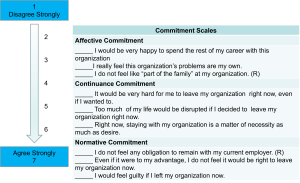11-3: Other Work-Related Attitudes
 More Than Just Liking Your Job: Organizational Commitment
More Than Just Liking Your Job: Organizational Commitment
You know that feeling when you’re really invested in something? Maybe it’s your sports team, your school, or a cause you believe in? That deep sense of connection and loyalty you feel – that’s similar to what we call organizational commitment in the workplace.
Organizational commitment represents how strongly you identify with and get involved in your particular organization. Like patriotism or school spirit, organizational commitment includes emotional attachment, thoughtful evaluation, and behavioral loyalty toward your employing organization.
Organizational commitment relates to job satisfaction with correlations typically ranging from .30 to .40, suggesting substantial overlap while maintaining conceptual distinctiveness. However, the causal order remains unclear – does satisfaction lead to commitment, or does commitment enhance satisfaction? What we do know is that organizational commitment demonstrates greater stability than job satisfaction, suggesting that commitment represents deeper, more enduring attitudes that are less susceptible to short-term fluctuations in work experiences.
Allen and Meyer’s three-component model provides the most widely accepted framework for understanding organizational commitment. Each component represents different psychological states that bind you to organizations through distinct mechanisms.
Affective commitment involves emotional attachment to, identification with, and involvement in organizations. When you have strong affective commitment, you remain with organizations because you want to, deriving satisfaction and meaning from organizational membership. Affective commitment represents the most desirable form of commitment from both employee and organizational perspectives, as it reflects genuine psychological investment in organizational success.
Continuance commitment reflects your awareness of costs associated with leaving organizations. These “sunk costs” may include lost pension benefits, forfeited vacation time, need to relocate, loss of seniority, or difficulty finding comparable employment. When you have strong continuance commitment, you remain with organizations because you need to, even if you’re not emotionally attached. This form of commitment may create compliance without genuine engagement.
Normative commitment reflects your feelings of obligation to remain with organizations based on moral or ethical considerations. When you have strong normative commitment, you remain because you feel you ought to, often due to socialization experiences, organizational investments in your development, or cultural values emphasizing loyalty. This represents a sense of “moral commitment” to the organization.

Here’s what’s really interesting: the three components operate independently, meaning you may experience different combinations of commitment types. You might have high affective and normative commitment but low continuance commitment, indicating strong emotional attachment and felt obligation but minimal perceived costs of leaving.
What Builds Commitment? Understanding the Antecedents
Organizational mechanisms include socialization processes, formal rewards, company merchandise, and newsletters that build connection and identity with the organization. Effective onboarding programs, recognition systems, and communication strategies can enhance commitment development, particularly affective commitment.
Personal characteristics show important relationships with organizational commitment. Age demonstrates positive correlations (.22) with affective commitment, suggesting that older workers develop stronger emotional bonds with their organizations over time. Job level shows positive relationships (.21) with affective commitment, indicating that higher-level positions foster greater organizational identification. Stress is negatively related to both affective commitment and continuance commitment (-.30s), suggesting that stressful work environments undermine commitment development.
Social factors prove crucial for commitment development. Relationships with supervisors (LMX) and coworker relationships show correlations of .30 to .45 with affective commitment, highlighting the importance of quality interpersonal relationships. Role ambiguity and conflict show negative relationships with commitment, indicating that unclear expectations and conflicting demands undermine organizational attachment.

What Happens When People Are Committed? The Consequences
Performance outcomes vary significantly across commitment types. Affective commitment relates to task performance (.15-.25) and organizational citizenship behaviors (.30), demonstrating that emotional attachment translates into beneficial work behaviors. Normative and continuance commitment do not relate as consistently to organizational citizenship behaviors or task performance, suggesting that obligation-based and cost-based commitment may not generate the same discretionary effort as emotional commitment.
Withdrawal behaviors show strong relationships with commitment, particularly affective commitment. Affective commitment has been found to relate moderately (-.18 to -.25) to absence and strongly to turnover variables like intent to search (-.60) and actual turnover (-.28). These relationships demonstrate that employees with stronger emotional bonds are much less likely to leave their organizations. Normative commitment shows somewhat weaker relationships with turnover, while continuance commitment may actually increase retention through perceived costs rather than positive motivation.
Counterproductive behaviors show theoretical relationships with organizational commitment, though empirical support remains limited. Frustration plays a strong role in counterproductive behaviors, as do the values and goals communicated by an organization. While there is no strong empirical support for relationships between organizational commitment and counterproductive behaviors, there are many theoretical reasons to expect such connections, particularly through the mediating role of frustration and value conflicts.
When You Become One with Your Organization: Organizational Identification
Organizational identification represents the degree to which you tie your identity to the organization you work for. This concept builds on social identity theory, which proposes that: (1) People value and seek self-esteem, (2) group memberships play a role in a person’s self-concept, and (3) individuals seek to maintain a positive social identity by making favorable distinctions between their social in-group and other out-groups (van Dick, 2004).

Organizational identification is often measured using a visual scale with overlapping circles. There are five rectangles, each containing two circles representing you and your organizational unit. In the first rectangle, the circles are totally separate, representing no identification with the unit. In the last rectangle, the circles are totally overlapping, representing complete identification. You choose the rectangle that most accurately represents the extent to which you identify with your unit.
This measurement approach captures the psychological merger between personal and organizational identity that characterizes strong organizational identification. When identification is high, organizational successes and failures are experienced as personal successes and failures, creating powerful motivation for organizational support and performance.
The Engagement Spectrum: Additional Work-Related Attitudes
Job involvement encompasses the extent to which you’re cognitively engaged in your job. This concept is also known as “flow” and represents deep psychological engagement with work activities. Job involvement moderates the effect of job insecurity on stress, negative attitudes, physical health, and psychological distress, suggesting that involved employees are more resilient to organizational threats.
Job involvement is related to organizational citizenship behaviors and task performance, with stronger relationships found for women than men. This pattern may reflect different socialization experiences or work role expectations that influence how involvement translates into performance outcomes.
Workaholism represents preoccupation with job activities that goes beyond healthy engagement. Unlike job involvement, which reflects positive engagement, workaholism often involves compulsive work behaviors that may be detrimental to well-being and relationships. Understanding the distinction between healthy involvement and problematic workaholism helps organizations promote engagement while preventing burnout.
Work centrality measures the importance work plays in your life relative to other life domains such as family, leisure, and community involvement. Correlations between work centrality, workaholism, and organizational commitment range from .25 to .45, suggesting meaningful relationships while maintaining conceptual distinctiveness.
Work centrality is positively related to salary level, number of promotions, and career satisfaction, indicating that individuals who place high importance on work tend to achieve greater career success. However, this relationship may also reflect selection effects, where successful individuals develop stronger work centrality over time.
When Organizations Have Your Back: Perceived Organizational Support
Perceived organizational support (POS) encompasses your global beliefs about the extent to which organizations value your contributions and care about your well-being. POS represents a reciprocal relationship perspective where you assess whether organizations treat you well and deserve loyalty and commitment in return.
Think of it this way: POS is like asking yourself, “Does my organization really care about me as a person, or am I just a replaceable cog in the machine?”
Antecedents of POS include fair organizational procedures that demonstrate respect for employee rights and interests. Supervisor support serves as a proxy for organizational support, particularly when supervisors are viewed as organizational representatives. Favorable rewards and job conditions signal organizational investment in employees while creating positive experiences that enhance POS perceptions.
Consequences of POS include increased organizational commitment, improved performance, and decreased withdrawal behaviors. When you perceive high organizational support, you typically reciprocate with increased loyalty, effort, and citizenship behaviors. POS creates psychological contracts based on mutual obligation and care rather than purely economic exchange.
POS is negatively related to workplace “politics,” suggesting that perceived organizational support suffers when employees observe self-serving behaviors and unfair influence attempts. Organizations that minimize political behaviors while demonstrating genuine care for employee welfare are more likely to achieve high POS levels.
What the Experts Say: SIOP Insights on Job Attitudes
Recent guidance from the Society for Industrial and Organizational Psychology (SIOP) reinforces the critical role of job attitudes in shaping workplace behavior and organizational outcomes. According to SIOP, job satisfaction, organizational commitment, and perceived organizational support are among the most influential predictors of employee engagement, performance, and retention.
SIOP emphasizes three key takeaways:
- Job Satisfaction Is Foundational: While job satisfaction alone doesn’t guarantee high performance, it is strongly linked to reduced turnover, absenteeism, and burnout. Satisfied employees are more likely to engage in organizational citizenship behaviors and contribute to a positive workplace culture.
- Commitment Goes Beyond Loyalty: Organizational commitment—especially affective commitment—predicts not only whether employees stay, but how they perform and advocate for the organization. SIOP encourages organizations to foster commitment by aligning work with employee values and providing meaningful development opportunities.
- Support Drives Engagement: Perceived organizational support (POS) is a powerful driver of motivation and well-being. When employees believe their organization values their contributions and cares about their well-being, they are more likely to reciprocate with loyalty, effort, and discretionary effort.
Practical Recommendations from SIOP:
- Conduct regular attitude surveys to monitor trends and identify areas for improvement.
- Train leaders to demonstrate fairness, empathy, and support in daily interactions.
- Design jobs that offer autonomy, task significance, and opportunities for growth.
- Recognize and reward behaviors that align with organizational values and goals.
By applying these evidence-based practices, organizations can cultivate a more engaged, resilient, and high-performing workforce.
Conclusion
Job attitudes represent complex psychological phenomena that significantly influence your behavior and organizational outcomes. Understanding these attitudes requires appreciating their multifaceted nature, including cognitive, affective, and behavioral components that interact to shape your experiences and responses.
The relationship between attitudes and behavior proves more complex than initially assumed, with various factors moderating when and how attitudes influence actions. Organizations seeking to leverage attitude management for improved performance must understand these complexities while developing sophisticated approaches that address multiple influences on employee attitudes.
Why does this matter for you? Because whether you’re planning to be an employee, manager, or entrepreneur, understanding job attitudes isn’t just academic knowledge – it’s practical wisdom for navigating and succeeding in the modern workplace. Organizations that truly understand and enhance employee attitudes gain significant advantages through improved performance, higher satisfaction, and reduced turnover.
The field continues to evolve through improved theoretical understanding, methodological advances, and recognition of cultural and technological influences on job attitudes. Future developments will likely emphasize personalized approaches, dynamic modeling, and integration with broader organizational systems that influence employee experiences.
Success in job attitude management requires ongoing attention to research developments, employee feedback, and organizational outcomes that reflect attitude effects. Organizations that approach attitude management as a strategic priority while respecting employee autonomy and well-being will be better positioned to achieve both individual and organizational objectives through positive employee attitudes.
Effective attitude management ultimately serves both practical and humanitarian goals by enhancing organizational performance while improving employee well-being and life satisfaction. This dual benefit justifies continued research and application attention to job attitudes as fundamental components of organizational psychology and human resource management.
Media Attributions
- Call Center Worker © Unknown is licensed under a Public Domain license
- Organizational Commitment Measurement © Jay Brown
- Organizational Commitment © Jay Brown
- Organizational Identification © Jay Brown
